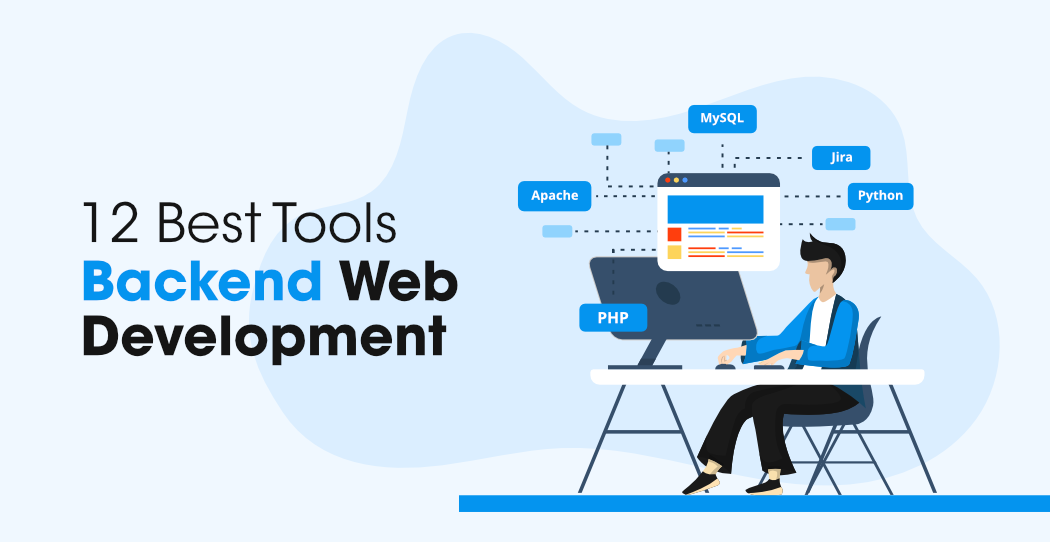While Frontend Web Development is concerned with the designing of the user interface of the website using web technologies like HTML, CSS, JavaScript, etc. – Backend Web Development (or you can say Server-Side Development) is responsible for the appropriate functioning of the website.
In simple words, when you visit an e-commerce website, let’s say Flipkart – the attractive layout and design of the website you see on your device are actually created by Frontend Developers but when you log in to your account, add the required items in the cart, do the payment and checkout – all these server-side functionalities comes under Backend Development.
Most probably, after reading the above-mentioned scenario, you would have understood that Backend Development is comparatively harder than Frontend Development. It is indeed a much vaster domain than it seems.
However, things can become a bit convenient and easier for the Backend Developers if they choose the right set of backend development tools available in the tech world. These tools are programming languages, frameworks, database management systems, web servers, testing & deployment tools, and various others. You can opt-out for these tools as per your requirements while doing Backend Development.
Now, let’s get started with top Backend Development Tools For Web Developers:
Programming Languages
1. PHP
PHP, an acronym for Hypertext Preprocessor, is a server-side scripting language and is one of the most widely used programming languages for backend web development. We can validate this statement by letting you know that platforms like Wikipedia, WordPress, Facebook, and many others are relying on PHP. This particular language is preferred for web development because of various prominent reasons such as cross-platform compatibility, OOPs features, easy integration with HTML, CSS, JavaScript, etc, huge community support, better flexibility & security, and many more. In addition, the language is quite easy to learn and use. Furthermore, there are various renowned PHP frameworks out there such as Laravel, Symfony, CodeIgniter, etc. that you can consider.
2. Python
Another language that is being preferred for backend development, specifically in current times, is Python. It is a high-level, general-purpose programming language that supports multiple programming paradigms such as Object-Oriented, Procedural, and Functional. Instagram, Spotify, Google, etc. are some of the popular platforms that are using Python in their tech stacks. The language provides you with some remarkable features such as rich library support, easy integration with other languages, GUI Programming support, compatibility with trending technologies, etc. Also, Python has a very simple syntax and comes up with better code readability aspects that subsequently make it easy to learn and use. Several popular Python web frameworks to you can take into consideration are Django, Flask, etc.
3. JavaScript
Honestly, JavaScript needs no introduction for its extensive role in web development. It is actually one of the fundamental units of web development alongside HTML and CSS. The language is being preferred by a huge number of developers for web development, and it is ranking at the top position as well at various renowned indices for top programming languages. Apart from web development, the language can also be used for game development, mobile application development, etc. Some of the considerable features of this particular language are – Imperative & Structured, Light-Weight, Object-oriented Programming Support, Platform Independent, and many others. Also, the best part is that JavaScript can be used for both – Frontend Development and Backend Development.
Other languages that you can consider: Java, Go, Ruby, etc.
Frameworks
4. Laravel
Laravel is one of the most popular PHP frameworks available in the tech world. This open-source web framework follows the Model-View-Controller (MVC) architectural pattern and provides you with numerous enriching features like a built-in command-line tool called Artisan, pre-installed Object-Oriented and Modular libraries, Eloquent ORM (Object Relational Mapping), Template Engine, and many others. Moreover, the framework leverages you with various tools for particular tasks like dependency injection, unit testing, etc. The ready-to-use packages provided by Laravel include Cashier for managing subscription billing services, Envoy that provides a clean & minimal syntax for defining common tasks you run on your remote servers, Socialite for the simplified mechanism for OAuth authentication with providers like Facebook, GitHub, Google, etc. and various others.
5. Django
Django is a Python-based open-source web framework that allows you to do web development more efficiently and without any hassle. Django follows the model-template-views (MTV) architectural pattern. The reason behind the immense popularity and demand for this particular framework is some of its noticeable features such as extensibility, rapid development, scalability, security, vast community, and many more. Businesses are using Django for various distinct web development areas such as social networking platforms, scientific computing platforms, content management systems, and various others. Some of the popular websites that are using Django are – Instagram, Mozilla, Pinterest, etc. If you want to get into web development using Python – you can surely give it a try to Django.
Other frameworks that you can consider: Angular, Meteor, Spring, Ruby on Rails, etc.
Databases
6. MongoDB
MongoDB is a free and open-source document-oriented database that is very much popular among web developers. This NoSQL database uses JSON-like documents with optional schemas for storage & retrieval of data and comes up with much-needed scalability and flexibility. MongoDB provides you with numerous prominent features such as Ad-hoc queries, Indexing, Replication, Load Balancing, File Storage, Aggregation, Transactions, etc. In addition, the security and data recovery aspects of this particular database are quite better compared to various other database management systems. Other than that, MongoDB is compatible with various standard programming languages like C/C++, Java, PHP, Python, Ruby, and several others.
7. MySQL
MySQL is another open-source relational database management system that is widely used for web-based applications. It is a fast and high-performance database that provides better scalability, usability, and reliability. Also, MySQL provides cross-platform compatibility, strong indexing support, SSL support for secured connections, powerful data encryption and accuracy, built-in replication support, and various other features. Meanwhile, MySQL can work on various distinct operating systems and is compatible with many popular languages like PHP, Java, etc. Let us tell you this as well that this particular framework, MySQL, is used by various renowned websites like Flickr, Twitter, Facebook, Drupal, Joomla, and many others.
Other databases that you can consider: Oracle, PostgreSQL, etc.
Web Server
8. Apache
The Apache, or you can say Apache HTTP Server, is an open-source cross-platform web server that was developed by the Apache Software Foundation. It is one of the leading web servers, and you can understand it with the fact that approximately half of all the websites across the world are powered by Apache. There are numerous worthwhile features that come up with Apache like Loadable Dynamic Modules, Multiple Request Processing modes, CGI support, User and Session tracking, Real-time status views, XML & FTP support, and many others. Also, the Apache Web Server is very much compatible with almost all operating systems such as Linux, macOS, Windows, etc.
9. NGINX
NGINX is another open-source web server that is also being used for reverse proxying, load balancing, caching, mail proxying, and more. It uses an asynchronous event-driven approach to handle requests and subsequently its modular event-driven architecture provides more expected performance under high loads. Some of the enriching features of the NGINX web server are – handling static files & auto-indexing, IPv6-compatible, URL rewriting & redirection, etc. Other than that, various additional features such as advanced load balancing, session persistence based on cookies, Cache Purging API, etc. are included in NGINX Plus. Dropbox, Netflix, WordPress.com, etc. are some of those popular platforms that are using NGINX.
Other web servers that you can consider: Lighttpd, Microsoft IIS, etc.
Other Tools
10. Docker
Docker is indeed the most recommended tool for all developers. It is a containerization platform that allows you to create, deploy, and run applications without any hassle with the help of containers. Docker leverages you with a consistent and isolated environment and is responsible for the isolation and segregation of your apps and resources in such a manner so that each container becomes able to access all the required resources without disturbing or depending on another container. Some of the other considerable advantages of using Docker are – Rapid Application Deployment, Scalability & Flexibility, In-Built Version Control System, Security & Cost-Effective, and many others.
11. Postman
Talking about the Postman, it is an Application Programming Interface (API) tool that allows you to build, test, and modify APIs conveniently and efficiently. It is used by millions of developers across the world to make the process of API building much easier and simple. Postman provides you with numerous additional enriching advantages such as support for various HTTP methods, API to code conversion, saving progress, converting the API to code for various languages, and many more. Also, with Postman, you can automate manual tests and integrate them into your CI/CD pipeline – so that any changes in the code would not break the API in production.
12. Jira
Another tool that you can consider to make the web development process more fluent and smooth is Jira. Jira is a project management platform that uses the kanban and scrum workflows for managing projects. It helps you to plan, track and do report work for the development of agile projects conveniently. Also, you get access to numerous advanced reports with real-time and actionable insights. Moreover, you need to know that Jira is very much customizable compared to other project management tools. Other than that, you can explore Jira’s automation engine as well that allows you to automate tasks and processes without any hassle.
Wait wait…!! Let us tell you the list doesn’t end here. Apart from these above-mentioned Programming, Frameworks, Databases, Web Servers, Project Management Tools,, etc – there are numerous other tools as well that are equally important, and you can explore them also as a backend web developer. For instance, you can further explore various Code Editors and IDEs, Website Performance Tools, Testing Tools, and so on as per your requirements!!





